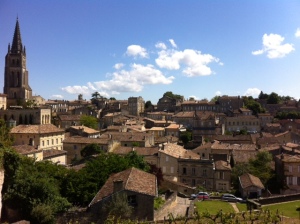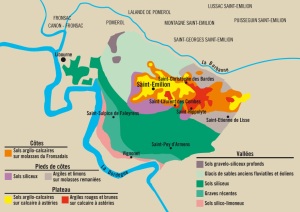A little synopsis of St Emilion; facts and figures and an explanation of its confusing classification and different styles. The St Emilion appellation (5565 ha) lies on the Right Bank of the Dordogne River to the East of Bordeaux city (around 45 minutes drive) and is well worth visiting.
Due to its predominantly clay soils, St Emilion is mainly planted with the early-fruiting Merlot which thrive in the colder stones of clay and limestone which slows down it down lengthening its growing sesaon creating more complex wines. The vineyards are planted with 75% Merlot, 20% Cabernet Franc (Bouchet), rest is Cabernet Sauvignon and a little Malbec (Pressac).
St Emilion Facts and Figures
Approximately 800 châteaux
Total Hectares St Emilion: 5,565 ha (13,590 acres)
3,739 ha Grand Cru St Emilion + 1,826 ha St Emilion
Separate are the St Emilion Satellite Village Appellations;
Montagne (1582 ha), St Georges (200 ha), Lussac (1,471 ha), Puisseguin (756 ha)
Production: 250,000 hl (5% production of Bordeaux’s red wine)
The medieval village of St Emilion, founded in the 8th century by a Benedictine monk Emilian, lies on a limestone plateau at the centre of the appellation. St Emilion has been listed as a UNESCO World Heritage site since 1999. Its best terroir is found on the plateau and its foothills ‘pied de côtes’ and also to its North East on the borders of Pomerol where a deposits of gravel enable more Cabernet (Sauvignon and Franc) to be grown.
One of the particularities of St Emilion is its varied soils though most have a high degree of clay and are ‘colder than the dry gravelly soils of the Médoc. The draining capacity of the hillside vineyards make some plots warmer than others especially those facing South.
It has six main types of soils;
1. Old Alluvia (highlighted in green) – these loamy gravelly sands vary in composition and are found on the plains towards the Dordogne River. They produce supple, light, aromatic wines.
2. Hillside Sandy Clay Soil (highlighted in violet) – these sandy and clayey soils are located on the foothills ‘pieds de côtes’ that slope down from the limestone plateau. This is qualitative terroir producing dense, complex wines. Châteaux Larciss Ducasse, Angélus, Canon La Gaffeliere,
3. Limestone Clay on Fronsadais Molasse (highlighted in orange). This terroir is located just off the limestone plateau as the vineyards begin to descend. It is highly qualitative terroir producing dense, complex wines. Châteaux Pavie (Premier Grand Cru Classé A), La Gaffeliere (Premier Grand Cru Classé), L’Arrosée, Pavie Macquin.
4. Limestone Clay on Asteriated Clay (highlighted in yellow) – located on the plateau this terroir has the highest number of Premier Grand Cru Classé properties including Ausone (Premier Grand Cru Classé A), Beausejour Bécot, Canon, Clos Fourtet. It has many underground cellars that originated from the limestone quarries.
5. Old Sand on Clay or Iron Sludge ‘Crasse de Fers’ (highlighted in light blue) – located in the valley to the north and north east of St Emilion. Produces a wine that is silky and round with an elegant structure. Châteaux Grand Corbin Despagne, Corbin Michotte,
6. Deep Siliceous Gravel with a Clay Subsoil (highlighted in dark grey) This is the ‘warm soil par excellence in St Emilion with its gravels it can support the Cabernet Franc and even Cabernet Sauvignon grape. Very good terroir producing dense strong wines with great ageing potential. Châteaux Cheval Blanc and Figeac.

The St Emilion Classification
St Emilion was first classified in 1954 originally with 12 Premier Grand Cru Classé and 63 Grand Cru Classé. It is the INAO that is responsible for it.
It is the only classification that is updated every ten years (1954, 1969, 1986, 1996, 2006). There was much controversy in 2006 when the classification was judged invalid following a series of legal battles returning to the 1996 classification.
The controversy continued with the 2012 version (see below). Seventy percent for the Premier Cru Classé wre based on the quality of the property , not the wine!
See my comments on the politics of the recent appellation;
ST EMILION CLASSIFICATION (1954) 2012
Premiers Grands Crus Classés x 18 (4 x A and 12 x B) increase of 2 A and 4 B
Château Angélus (A), Château Ausone (A) Château Beauséjour (héritiers Duffau-Lagarrosse,) Château Beau-Séjour-Bécot, Château Bélair-Monange, Château Canon, Château Canon la Gaffelière, Château Cheval Blanc (A), Château Figeac, Clos Fourtet, Château la Gaffelière, Château Larcis Ducasse, La Mondotte, Château Pavie (A), Château Pavie Macquin, Château Troplong Mondot, Château Trottevieille, Château Valandraud
Grands Crus Classés x 68 (increase of 16)
Château l’Arrosée, Château Balestard la Tonnelle, Château Barde-Haut, Château Bellefont-Belcier, Château Bellevue, Château Berliquet, Château Cadet-Bon, Château Capdemourlin, Château le Chatelet, Château Chauvin, Château Clos de Sarpe, Château la Clotte, Château la Commanderie, Château Corbin, Château Côte de Baleau, Château la Couspaude, Château Dassault, Château Destieux, Château la Dominique, Château Faugères, Château Faurie de Souchard, Château de Ferrande, Château Fleur Cardinale Château La Fleur Morange, Château Fombrauge, Château Fonplégade, Château Fonroque, Château Franc Mayne ,Château Grand Corbin, Château Grand Corbin-Despagne, Château Grand Mayne, Château les Grandes Murailles, Château Grand-Pontet, Château Guadet Château Haut-Sarpe, Clos des Jacobins, Couvent des Jacobins ,Château Jean Faure, Château Laniote, Château Larmande, Château Laroque, Château Laroze, Clos la Madeleine, Château la Marzelle, Château Monbousquet, Château Moulin du Cadet, Clos de l’Oratoire, Château Pavie Decesse, Château Peby Faugères, Château Petit Faurie de Soutard, Château de Pressac, Château le Prieuré, Château Quinault l’Enclos, Château Ripeau, Château Rochebelle, Château Saint-Georges-Cote-Pavie, Clos Saint-Martin, Château Sansonnet Château la Serre, Château Soutard, Château Tertre Daugay (Quintus), Château la Tour Figeac, Château Villemaurine, Château Yon-Figeac







